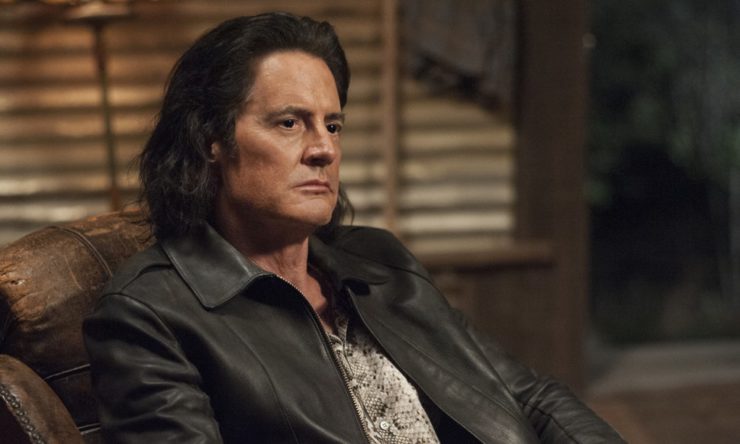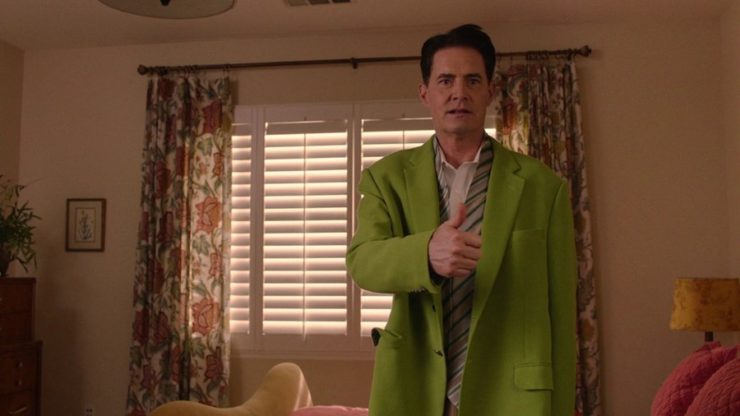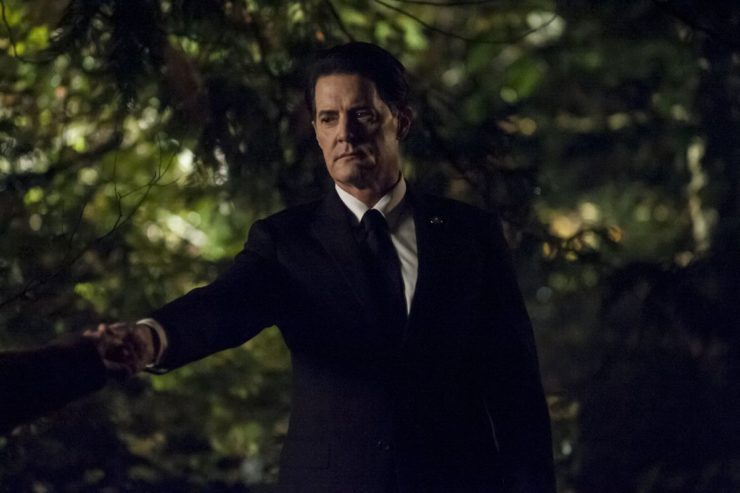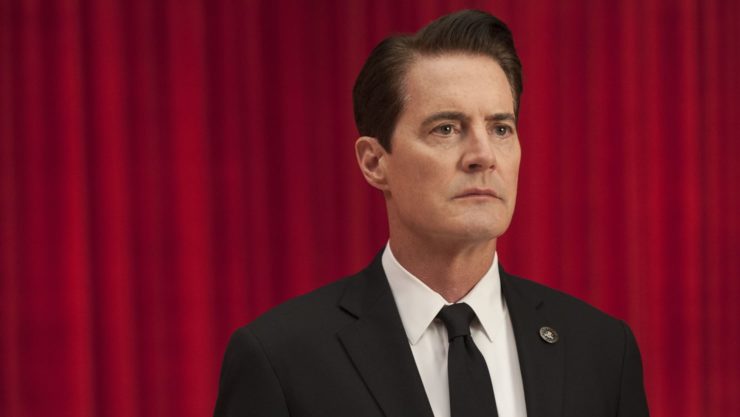“We are like the dreamer who dreams, and then lives inside the dream. But who is the dreamer?”
Few lines from Twin Peaks encapsulate the cult television series better than these, spoken by actress Monica Bellucci, playing herself inside another character’s dream. The declaration doesn’t just serve as a thesis statement for the famously surreal director David Lynch, who co-created the series with veteran TV writer Mark Frost; it also reminds the viewer that Twin Peaks operates according to a dream logic, rarely cohering into an objectively clear narrative. Interpreting the series means acknowledging incongruities and accepting that our readings are deeply personal, and even the most brilliant connections and explanations are likely to be undercut by other aspects of the show. That slippery, open-ended quality is the very essence of Twin Peaks, and nowhere is that clearer than in the third season, set 25 years after the events of the original show.
Mutability has been part of Twin Peaks since its original 30-episode run, but viewers don’t always accept it. Despite the series becoming a pop sensation in 1990, audiences once enraptured by the mystery surrounding murdered homecoming queen Laura Palmer (Sheryl Lee) and the investigation by pie enthusiast/FBI Agent Dale Cooper (Kyle MacLachlan) quickly grew impatient with Frost and Lynch’s idiosyncrasies. Many who stuck with the show later felt betrayed when the 1992 prequel film Fire Walk With Me eschewed several of the series’ beloved characters, and its lighter tone, for a grueling look at the last week in Laura Palmer’s life.
In the 25 years that followed, fan and critical opinion shifted, with the series and movie now considered groundbreaking, prompting Showtime to debut an 18-part third season, titled Twin Peaks: The Return, on May 21, 2017. However, despite initial enthusiasm, audience size and appreciation waned as The Return’s wider scope and slower pace sidelined even Agent Cooper. Once again, viewers were angry and annoyed that their idea of Twin Peaks wasn’t the one unfolding on TV.
Returning to The Return a year after its initial broadcast, one realizes that demanding uniform coherence is a weird way to approach a show about dreamers and doppelgängers and diverging timelines. There’s no one version of Twin Peaks; the town and its inhabitants change according to who’s dreaming the dream, and according to who’s watching the show. The various plots line do not necessarily come together more clearly during a rewatch of season 3, but one can see how they run parallel or extend from one another, simultaneously inviting a variety of interpretations and rejecting any that one might claim to be final or definitive.
The series’ many metatextual elements reinforce this multiplicity, especially Audrey Horne’s (Sherilyn Fenn) fourth-wall breaking narrative; but the most interesting example is The Return’s central arc, in which MacLachlan plays four different versions of Agent Cooper. The primary Cooper begins The Return where we left him in the original series finale, trapped in the mystical Lodge—the place where amoral “Lodge spirits” speak in backmasked riddles—and replaced on Earth by an evil doppelganger called “Mr. C.” He spends the first two parts of The Return escaping the Lodge, but is thwarted by the doppelgänger and diverted into yet another double, an empty-headed Las Vegas insurance agent named Dougie Jones. His mind lost somewhere inside the mindless Dougie Jones, Cooper prime disappears until late in Part 16. After stopping Mr. C and traveling back in time to prevent Laura’s death, Cooper resets reality and is replaced again, this time by a figure we’ll call “Richard.”

While the Cooper prime and Mr. C plots can be read as simple “good versus evil” stories, Lynch and Frost rarely let their characters of the hook so easily. Mr. C is less a malevolent copy of Cooper and more his dark impulses personified, loosed when he succumbed to fear during the original series finale’s Lodge sequences. The various Coopers are all still Cooper, just radically different takes coexisting at the same time.
But the Dougie Jones and Richard versions of Cooper can be further read as comments on how to interpret Twin Peaks, from two different perspectives: the former is an example of a character subject to too many expectations and the latter a a cautionary tale against holding to a single reading.
Although Dougie Jones existed before Cooper took his identity, MacLachlan plays him as a perfectly blank slate, without interiority. Everyone who encounters Dougie imprints their expectations on him, from his wife Janey-E (Naomi Watts) to his boss Bushnell Mullins (Don Murray) to the criminal Mitchum Brothers (Jim Belushi and Robert Knepper). Because there is no one there in Dougie Jones, everyone sees in him what they want to see, a joke Frost and Lynch underscore by having him constantly parrot back what others say to him.
For example, Janey-E seduces Dougie in The Return Part 10. Lynch plays the scene comically, opening with a pan up from Janey’s crossed feet to her looking longingly at Dougie, who absent-mindedly munches on cake. “Dougie, do you find me attractive?” she asks, before declaring, “I find you attractive.” Lynch accentuates the joke with shot reverse shots between Janey’s flirtatious smiles and Dougie shoving chocolate cake into his expressionless face, culminating with a ridiculous cut from Dougie’s blank stare at the kitchen table to Janey climaxing with him in bed. The scene closes with Johnny Jewel’s ethereal music accompanying the couple snuggling together. “Dougie, I love you,” Janey purrs, to which Dougie responds in his characteristic manner, echoing, “Love you.”

Despite clearly enjoying the physical sensations he’s just experienced, Dougie means nothing by his response. Nor does he mean anything when he shouts “Hellooooo” at jackpot-winning slot machines or when he orders a defeated rival to “Thank Dougie.” He’s just repeating what he hears, and people interpret these statements however they want, because Dougie is a big nothing, a walking gap.
More specifically, he’s an Agent Cooper-shaped gap, and while some (like me) truly enjoyed Dougie’s antics, his continued presence (and Cooper’s continued absence) frustrated many viewers. But rewatching the series, knowing that Cooper will not return until the end of Part 16, we can see ourselves parodied in Dougie’s storyline. To make Twin Peaks meet our expectations is to make it into Dougie: amiable but empty, able only to echo back whatever we say about it, whatever story we want to hear. And while that’s fun for a bit, that’s nowhere near as satisfying as the complexly weird show Frost and Lynch want to give us.
The Richard storyline presents the opposite scenario, in which someone tries to rigidly control the thing he loves. Cooper becomes Richard after finally waking from the Dougie persona and defeating Mr. C. Using the Lodge’s time travel capabilities, Cooper sets out to make right Twin Peaks’ ultimate wrong by intercepting Laura on the night of her death. Part 17 ends with Cooper leading Laura through the woods, away from the place where she would be raped and murdered, until she disappears with a scream and a rustling sound. The episode then replays the first scenes of the original series premiere, complete with Pete Martell (Jack Nance) heading out to fish. But instead of finding Laura “dead, wrapped in plastic,” as he does in the 1990 pilot episode, Pete continues on uninterrupted, indicating to viewers that Cooper has erased the story in which he lived. By demanding that everything adhere to his version of the dream, Cooper destroyed his dream.
The Return’s last part plays out back in the present, in this new world in which Laura never died, a world radically different than the one we once new. The once vibrant town feels ordinary, complete with a closed up and shabby-looking Double R Diner. Laura Palmer no longer seems to exist, replaced by lifelong Texas resident Carrie Page (played by Sheryl Lee). And Cooper’s partner Diane (Laura Dern) treats him like a stranger, referring to herself as Linda and to him as “Richard,” before leaving him because “I don’t recognize you anymore.”
We don’t recognize him either, at least not as Agent Cooper. Aspects of the principled man from the originally series do occasionally shine through, as when he stops a trio of cowboys hassling a waitress in a Texas diner. But instead of disarming them with wit and resolve, Richard attacks the assailants and frightens bystanders with his Mr. C-like commands. Richard is not only a less idealized take on a government agent—he’s also a combination of Cooper prime and Mr. C (with a little Dougie popping up in his expressionless face).
We may dislike Richard and want to reject him as Cooper, but his arc acts as a warning against that impulse. Cooper’s determination to save Laura, to put the world back to the way he thought it should be, seems to have undone reality, but he continues that same mindset as Richard. He pulls Carrie Page out of her hometown and drives her from Odessa, Texas to the Palmer house in Twin Peaks, Washington, determined still to return Laura to her rightful place, even if this Laura isn’t Laura. Frost and Lynch repeatedly highlight the unsatisfactory nature of Richard’s quest by gesturing towards important incidents, including a dead body in Carrie Page’s living room and a car tailing the duo on their trip, and then disregarding them without comment.

The culmination of the trip is equally anticlimactic. Carrie fails to recognize the house or the town, still certain that she is not Laura Palmer, and the woman who answers the door (played by Mary Reber, the real-world owner of the Palmer house) name-drops the Chalfonts and the Tremonds, names adopted by two Lodge spirits in the original series and in Fire Walk With Me, but offers no other connections to the town as we know it. And then the troubling final moments, in which Richard and Carrie walk away, before Richard suddenly turns back toward the house and asks “What year is this?” and Carrie gives the Laura Palmer scream. Electricity buzzes, filling the soundtrack as the houselights shut off and the screen goes black.
Does this mean the end of Twin Peaks? There has been some talk of a fourth season, but it seems unlikely, meaning the blacked-out house is probably the last image we’ll have of our beloved town. Well, except Mark Frost’s epilogue book, The Final Dossier. And the fact that the entire series is readily available on physical and digital media, ready to be watched again and again. As we rewatch, our interpretation of it will necessarily change, and that’s what keeps the work alive—Twin Peaks will always continue as long as we rewatch and rethink it. The lights only go out when we close off other interpretations, because once we’ve figured it all out, what’s the point of returning?
Joe George‘s writing has appeared at Think Christian, FilmInquiry, and is collected at joewriteswords.com. He hosts the web series Renewed Mind Movie Talk and tweets nonsense from @jageorgeii.










